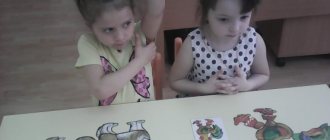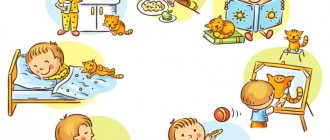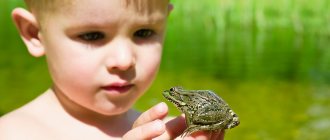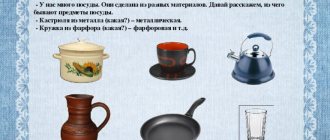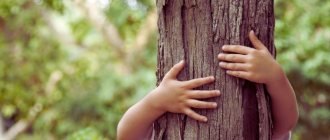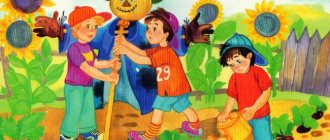Making pictures from parts
There is a lot of literature on this topic, I use these manuals:
- Children's health kit;
- A set of pictures on social development
- Illustrations on children's speech activity.
I also use homemade materials in my work, download pictures from the Internet and make games. So, that was a small digression, let's get back to the topic of conversation.
A drawing that is divided along straight lines into several parts is split. A preschooler should not think about the shape of a detail in a drawing; he concentrates on the full image.
When a child collects a drawing, he must imagine what he is collecting, what image he will get. In this case, he must correlate the pieces with the image so that the correct place is allocated to it. Otherwise the illustration will not work. This requires concentration, seriousness, and attentiveness from children.
When folding cut images, the baby begins to realize the objective integrity and compose an illustration from parts. He trains his memory, develops thinking, and spatial orientation. Drawings are great for improving fine motor skills. By consolidating knowledge about objects and phenomena, assembling a whole from pieces, the goal of the cut-out pictures game is formed.
Pictures for the puzzle to print
To make a regular puzzle for children with your own hands, just take any picture and cut it into any number of pieces. But with shaped puzzles everything is more complicated.
From simple to complex
At first it is better to use the simplest designs with a small number of individual pieces. The image should be familiar to the baby. A good option is two similar pictures, one of which is divided into 2 parts. In this case, one can be a sample.
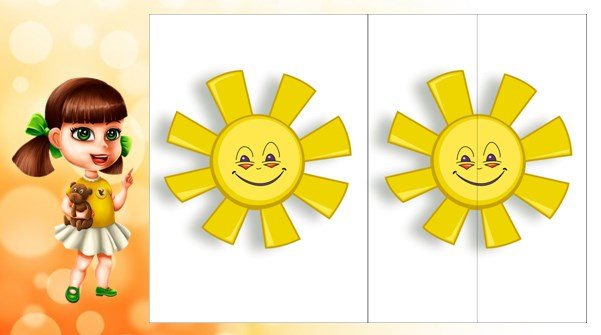
After the child masters this fun, he will not need an example picture. For this game, drawings from coloring books or old books will be useful. It will be much more interesting if you draw them yourself. Use bright, but not irritating colors.
First, cut the images into two, then into three parts. Then increase the number of pieces gradually when the child folds the previous drawing on his own. You should know that the number of elements collected increases, and their size decreases. There are times when a baby puts together pictures with large pieces easier.
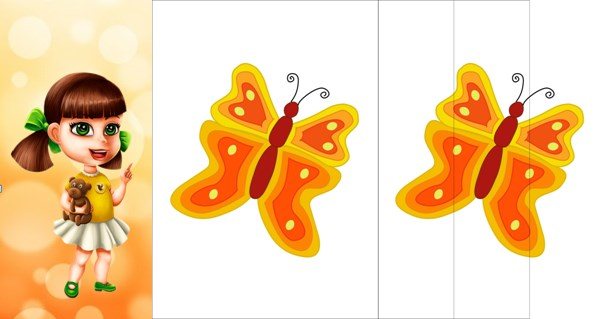
The number of items should be selected in accordance with the age and special qualities of your child.
Cutting pictures for kindergarten
Very often in kindergarten I involve older children in making such games for younger children, and preschoolers are happy to help me. But at the same time, I am pursuing my goals, my task is not only to attract a child to artistic work, but also to teach how to cut paper, while developing children’s hands and fingers.
Pay attention to the “Games” section, where you will find a lot of useful material.
The game of cut pictures is widely used in speech therapy activities with preschool children of the middle and senior groups. A speech therapist works with them and uses these games in his work.
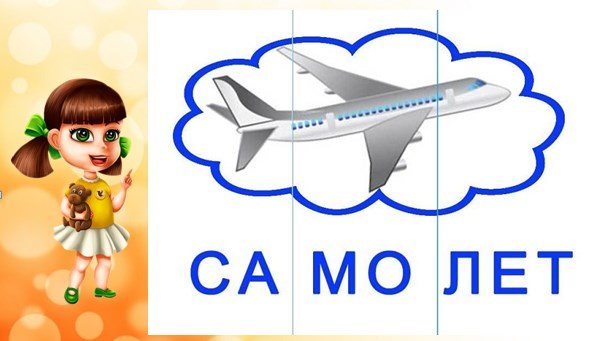
At every age, starting from 1.5 - 3 and continuing up to 7 years, the child is very interested in this fun, because with the help of it he learns the alphabet, toys, professions, transport, etc.
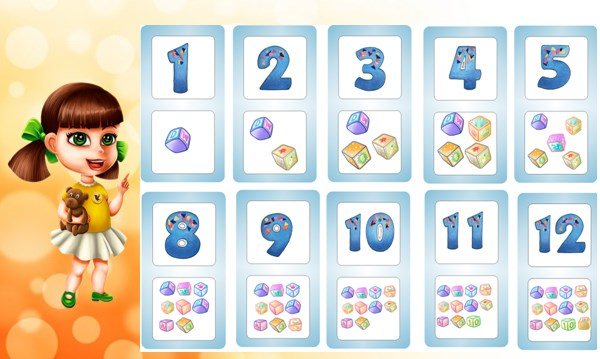
For preschoolers in the preparatory group, it is interesting to conduct such fun activities in mathematics. When compiling examples, I use the following pictures: in the upper part, for example, animals, toys or any objects, and in the lower part there is a number with the number of objects depicted in the picture. Such cut-out pictures for preschoolers can also be used to compose problems. An important indicator for assessing intellectual development in children is the success of putting together pictures from parts.
Methodology “Cut pictures”: description, application, interpretation.
“Cut Pictures” Method: Description, Application, Interpretation
The method of cut pictures is a kind of game that is necessary for children to develop ideas about the parts and integrity of objects, the formation of logical thinking, attentiveness, observation and many other equally important qualities. The essence of the lesson with cut pictures is that the child assembles a single whole from parts. The methodology in this case is a set of specific pictures, divided in a certain way and selected in accordance with the age group and goals.
What are the purposes of using cut pictures?
The main goal that any existing method of cutting pictures helps to achieve is the comprehensive development of the child. In addition to the main goal, the methods are also used to identify any disorders and diagnose the state of the child’s mental development. During classes, kids use visual and effective thinking, associative skills, motor skills and much more. Also, each existing method of cut-out pictures influences the child’s understanding of the environment and the formation of his aesthetic perception. Therefore, when choosing pictures for classes, you need to pay attention not only to the level of difficulty of the tasks and recommendations for age-appropriate use, but also to the content and quality of the pictures.
What do these pictures represent?
Any existing cut-picture technique uses images divided into parts. The older the child, the more complex the drawings are used as teaching material. Of course, the number of lines indicating cuts in the picture also increases. For example, for classes with very young children, the simplest possible image of one object, thing or something else is chosen. It could be a house, a car, a spoon, a plate or cup, a tree, a knitted hat, etc. The main requirement for a picture is one simple image of an object that is easily recognized by a small child. The picture is divided into two equal parts horizontally or vertically. This is what the teaching materials look like, which are used by any existing “Cut Pictures” technique for children aged two years. As a rule, in the departments of stores with educational games there are sets of pictures dedicated to certain topics: water procedures, dishes, the environment, boats, animals, and so on.
What is the difference between these pictures and puzzles?
This is a question asked by all parents who are interested in educational games and activities with their children. Any existing method of collecting cut-out pictures is fundamentally different from working with puzzles or other composite images. It lies in the fact that the puzzle leaves no room for error, its independent recognition and correction. In other words, puzzles do not allow imagination to develop, do not form analytical thinking and do not stimulate the need to compare the result of the assembly with the prototype of the image used.
Does this mean that the “Fold the cut picture” technique is better than the “Assemble the puzzle” activity? Of course no. These techniques develop various skills and abilities. For example, puzzles are much more effective at developing fine motor skills, instilling discipline and perseverance than images cut along smooth contours. Accordingly, kids need both pictures and puzzles.
How is the technique used in diagnosing the level of development?
The diagnostic technique “Folding cut-out pictures” in practice is no different from educational games or activities. As a rule, the purpose of the diagnostic use of the technique is to determine the degree of development in children of ideas about the integrity and completeness of images. It also becomes clear that their fantasies are adequate, their level of logical thinking skills, and many other aspects. Testing is carried out as follows: the child is offered a set of cards divided into parts with various images, from which he must create complete pictures and name them. Initially, the cards are in a mixed, chaotic and unsystematic position. The child takes out one card from this “pile” and voices his guess as to what part of the object is depicted on it. After that, he looks for the remaining parts of the drawing and combines them into a single whole.
Does teaching material change depending on age?
Each existing and practiced “Cut Pictures” technique, the author of which has a pedagogical education and experience working with children, uses different images for each age group. For children from two to three years old, pictures are usually used, divided into a couple of parts. Children who have crossed the three-year mark are given more difficult tasks. Pictures for them are divided into three or four parts. For children over four years old, the tasks are more complex. Images are divided into 4-6 elements. In addition to the number of parts into which the card is divided, the very nature of the image changes. If children aged 2-3 years are offered a simple one-component drawing depicting some easily recognizable object, then those who are five years old can already imagine images with several components, for example, a house with a fence and a person.
How are the results interpreted?
The diagnostic use of pictures cut into pieces not only allows one to draw conclusions about the level of development of children, but also to notice that they have certain skills. Three-year-old children with normal mental development, when forming a picture divided into a pair of parts, use the trial method, connecting the pieces until the correct result is obtained. Children who have crossed the four-year age threshold use the visual correlation method. This means that they do not take everything from the general “pile”, checking afterwards for a match, but try to initially select the necessary elements. Children with various mental development disorders cope with assembling a picture from two pieces only by the age of four. The task of assembling an image divided into four parts can cause difficulties for them even at the age of five. Mentally retarded children initially do not understand the essence of the task and simply rearrange pieces of images without trying to connect anything into one whole.
How are results scored?
As a rule, teachers use a four-point scale for assessment. Its meanings are as follows: 1 - unable to understand the requirements, grasp the essence of the task, inadequate chaotic actions when teaching and demonstrating an example; 2 - takes part in training, but cannot cope independently, makes mistakes, does not see the difference in the correct and incorrect image; 3 - does not have problems understanding the purpose of the lesson, makes connections by searching through options; 4 - completely fulfills. A score of “4” does not mean that the child never makes mistakes. Parents who use these methods with their children need to understand that children are not robots. Moreover, an inquisitive child sometimes wants not only to fulfill the conditions of the task assigned to him, but also to see what happens if the drawing is folded differently than required.
What are the advantages of cut pictures over other developmental activities?
The main advantage of using various options for activities with pictures cut into pieces over other educational games is that they allow the child to make mistakes, experiment and fantasize. In other words, such techniques provide children with complete and practically unlimited freedom to manipulate parts of the whole image. This is an extremely important point, since manipulation in this case is one of the ways to understand the world around us. These techniques also provide the child with the opportunity to feel control over the result and take responsibility for it. After all, it depends only on the child what form a tree, house, hat or any other image will take. The main task of parents is not to interfere with the child in his experiments, but at the same time to ensure that he adequately completes the task. It is important that the child understands the difference between fantasy and objective reality.
An example of a developmental lesson using this method.
The developmental methodology “Cut Pictures” for preschoolers, which is easy to practice at home, should contain several tasks, varying from simple to difficult. Of course, when choosing a material you need to take into account the age of the baby. There is no need to include pictures divided into two parts in tasks for six-year-old children. In the first stages, two-year-old children need not only to be provided with simple images divided into parts, but also to have a sample laid out in front of them, that is, a whole version of what should happen. For children over five years old, you can complicate the task by adding letters or syllables to the image, so that when you put the whole image together, you get a word. An example of a simple activity: the child is offered 8 or more cards cut into pieces and the same number of whole ones; the essence of the task is explained and completion is shown; the child collects pictures, placing them under the samples and names what is drawn on them. Classes are conducted according to this scheme. The cards themselves are divided into the number of parts that corresponds to the age of the child.

Method of playing the game
Having carried out the technique with cut-out drawings, for example, according to the seasons, you must first select pictures on this topic. The purpose of this method is to identify the skills of composing a whole image from parts. The task is to orientate by shape, color, size, identify visual figurative thinking, coordinate hand movements, as well as fine motor skills. How to do this fun?
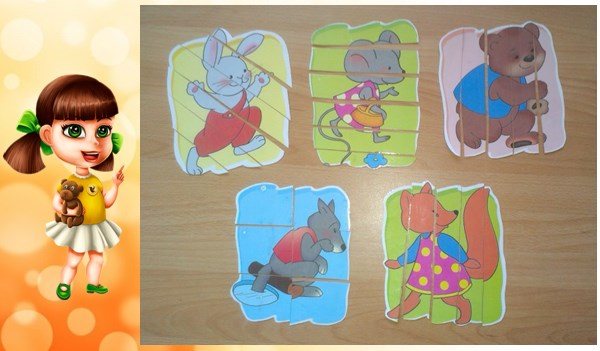
Before playing the game, the speech therapist lays out parts of the illustration, which consist of 4 parts, on tables for children. Then he invites the children to assemble the object, asks them to put the parts on the sample, remember the location of the parts in order to assemble the illustration themselves. After which the drawings are scattered, the sample is removed, inviting the children to collect them again. The child must name the object that is cut.
If a child puts the images together correctly on the first try, this means that his visual and figurative effective thinking is well formed. If a small child completed the task on the second attempt, then we can assume that his attention and imagination are poorly formed.
In a word, this technique helps the baby develop logic, memory, attention, imagination, thinking, activates speech and sensory perception.
Consultation for parents. About the benefits of puzzles and composite pictures
Natalya Vladimirovna Rozhkova
Consultation for parents. About the benefits of puzzles and composite pictures
Consultation for parents
About the benefits of puzzles and composite pictures
Today on store shelves you can find an incredible number of different puzzles and composite pictures. The purpose of the puzzles is to assemble a whole image from individual parts. Composite pictures come in different levels of complexity. There are 4 types of them:
1. Pictures - inserts.
2. Cut pictures.
3. Cubes with images.
4. Puzzles.
Let's take a closer look at each of the categories.
o Pictures – inserts
Very effective in the formation and development of visual and figurative thinking. They develop memory, attention, speech, logical thinking, hand motor skills, and imagination. They are introduced to geometric shapes, concepts of size, color, part and whole.
These are pictures with parts cut out. You need to find the missing pieces and put them in their places. The simplest option is when the cut out element has smooth edges and the depicted pattern is symmetrical, for example, a circle and a sun depicted on it. Then you can offer a picture with uneven edges. The next stage: the child is offered a picture with straight edges, but the image is asymmetrical, for example, a chicken depicted in a square. You can then offer inserts in which the cut-out elements are part of the look.
o Cutting pictures
Understanding the concepts of part and whole, practicing mechanical skills and perseverance. The foundations for combining and synthesizing a whole from parts are laid. There is an active development of speech, emotional sphere, visual-motor coordination and spatial perception.
Pictures cut along (in most cases) straight lines. You can start studying with the simplest cut pictures (a large object is depicted and divided into two parts) from the age of 1.5 years.
Over time, you can complicate the tasks by offering pictures consisting of more details. In the first stages, if the child cannot cope, help, collect the pictures yourself, tell them what is shown on them, ask questions during the process, make riddles about the objects. Invite your child to complete the almost finished picture by adding one detail, complicate the task each time - two details, three...
o Cubes with images
Visual-figurative thinking, the ability to work according to a model, visual memory, attention, and logic develop.
Cubes are a favorite game for almost all kids. You can start classes from 2 years old. With the help of cubes you can introduce different concepts to your child. For example, put a sample drawing of an apple at the bottom of the box. Ask your child to find the right part of the cube and put it in the box. As a result of the assembly, a drawing is obtained, and you tell what apples are, where they grow, what is prepared from them... Ask the child to put together a drawing without using a picture of the sample. Comment on the child’s actions: they placed the cube on the top right, now on the bottom left, developing the ability to navigate.
o Puzzles.
They develop imagination, logical thinking, fine motor skills, attention, and integrity of perception.
Puzzles differ from the cut-out pictures listed above in that they have a curved line connecting the parts. Therefore, you need to compare the shape of one part with the shapes of neighboring parts. You can start collecting puzzles from 3.5-4 years old. It is worth considering the child’s interest and the complexity of the puzzles. First, select those that include a small number of large parts. You can gradually complicate the game by increasing the number of parts and decreasing their size. The objects depicted on the puzzles should be familiar to the child. It is advisable if it is one large object, for example, a cartoon character. The first time you will need to assemble the picture yourself, and then remove 2-3 parts and tell the child: “I assembled the picture, but a strong wind blew and several parts flew away. Help me put it back together.”
MADOOU CRR – kindergarten
Teacher-psychologist Rozhkova N.V.
Source: “Growing Together” magazine.
Children's pictures: yandex.ru/images.
Recommendations for parents
Cutting pictures for children develop their sensory abilities.
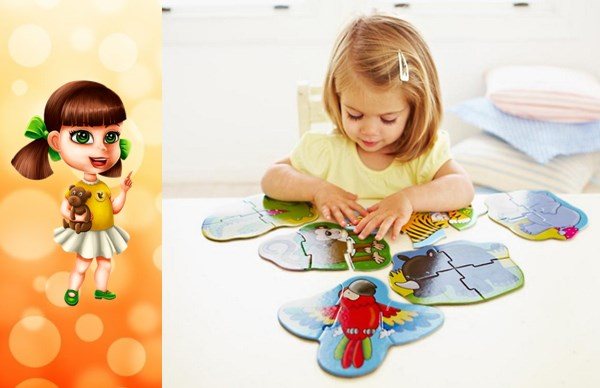
The tasks for adult groups are:
- development of the baby’s sensory abilities: restoration of the whole in parts;
- development of coordinated actions of hands and eyes through the ability to trace an image along a contour;
- knowledge of the object depicted in the illustration, its name and finding identical drawings;
- speech development, enrichment of the active vocabulary with the help of new words, as well as repetitions of familiar words.
The materials are object drawings from two sets. Two identical images are selected from each set. One picture is cut in half, and the other, as an example for selection, remains intact.
Tip #1
Use pictures that, when cut, form identical parts, connecting them, they will be like one whole, for example, a hare, a pyramid, a car, a chicken.
How to conduct classes? Use a surprise moment, let a fairy-tale character come to visit your son or daughter who does not know the names of the toys. For example: a clown drew toys and brought them to your baby so that he could tell what they are and how to play with them. Parents show entire illustrations and ask what is depicted on them. If the children answer correctly, you praise him. It will be good if you use a poem or beautiful figures of speech on the topic of the image.
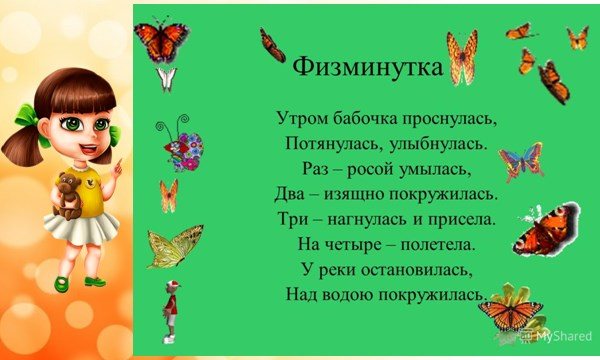
Don’t forget that children get tired quickly, spend some physical exercise in a playful way, fortunately there are a great many of them on the Internet.
When a preschooler looks at the drawings, an adult teaches him the ability to trace an object along the contour. Thus, sensory actions of the hands and eyes are developed, which help to recognize objects when examining their shape.
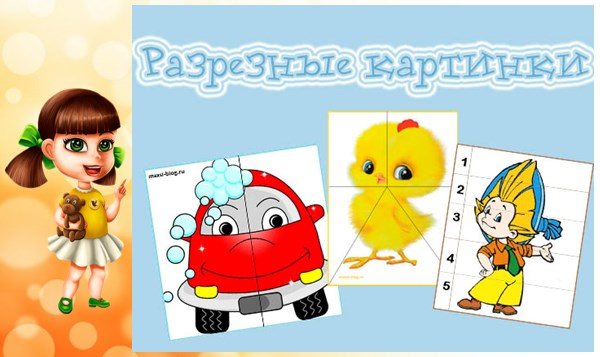
Next, the parent shows the same illustrations, which consist of two identical halves. Then he explains that the picture must be folded correctly, then you will get a whole pyramid, matryoshka or car. Then he shows how to add two identical halves, and also compares the created illustration with a similar image in the whole drawing that the clown brought them.
Then the task becomes a little more complicated, the parent gives the child 2 drawings, for example, a pyramid and a hare, a car and a chicken, a tomato and a cucumber. The child chooses images from two options that differ in color and shape. When classes are over, the adult praises the little one for the actions done.
Tip #2
Dear parents, to consolidate the material, you need to systematically repeat the lessons and further complicate them, i.e. cut illustrations into three, four, eight parts.
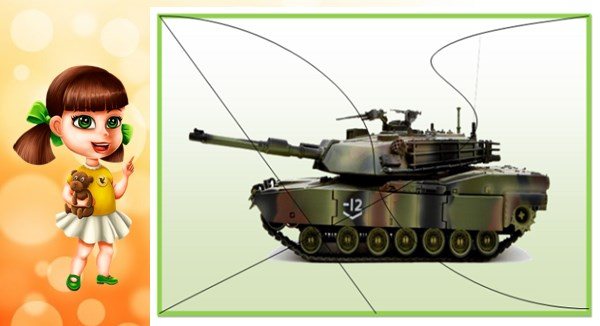
The game cut pictures for preschoolers allows them to get acquainted with their hometown, learn the names of domestic and wild animals, migratory birds and insects, indoor plants, flowers, trees, vegetables, fruits. It also helps to improve cognitive interests in fire safety and military equipment.
5/5 — (3 votes)
How to use printable assignments
How to work with picture puzzles for children:
- print out the proposed puzzle picture, prepare scissors, and, if desired, a clean sheet of paper and glue;
- Explain the task to the child. That's it, the part for adults is over;
- then completely independent work : cut the puzzle along the contours;
- reassemble the puzzle in the correct order;
- stick on a blank sheet of paper as a finished applique.
Please note that some pictures specifically do not contain lines and patterns flowing from one puzzle element to another. This kind of puzzle is more difficult to assemble; you need to rely only on the shape of the elements, and to do this you need to cut the picture very carefully.

